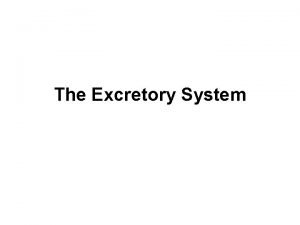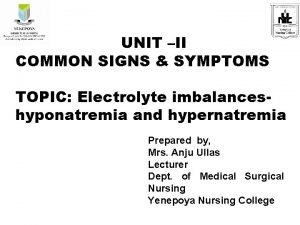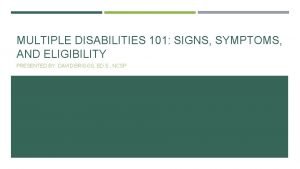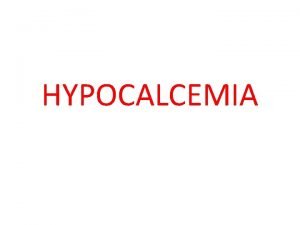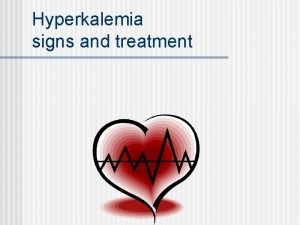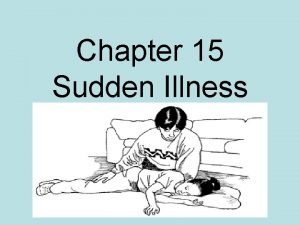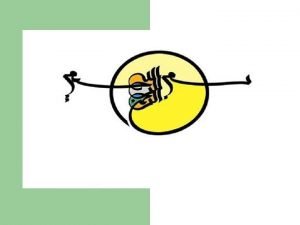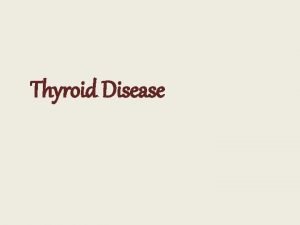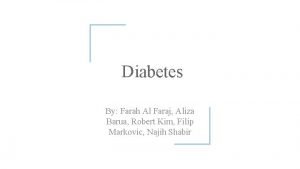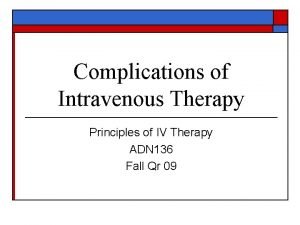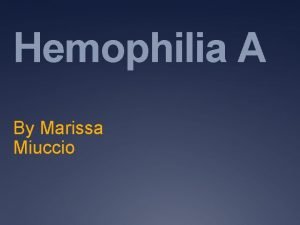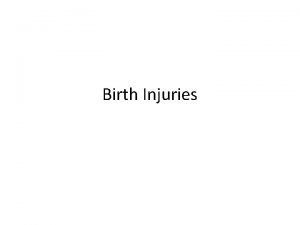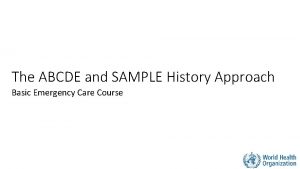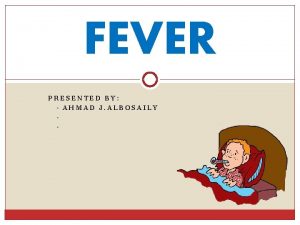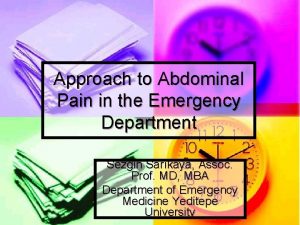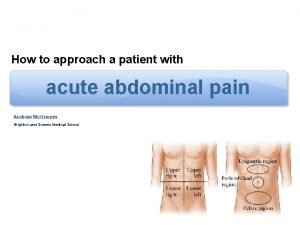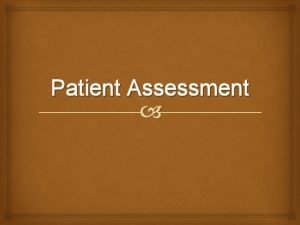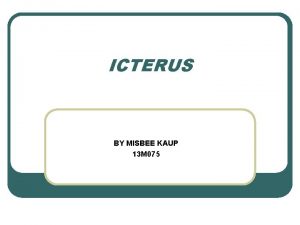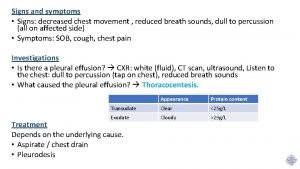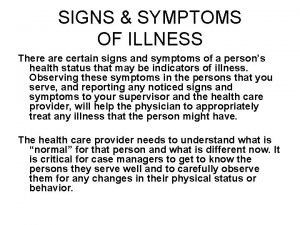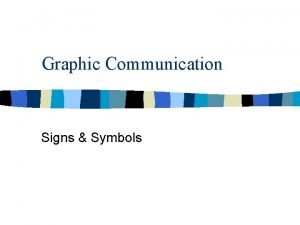TAKING HISTORY SIGNS AND SYMPTOMS IN KIDNEY DISEASES



























































- Slides: 59

TAKING HISTORY, SIGNS AND SYMPTOMS IN KIDNEY DISEASES Prof. Dr. Tekin AKPOLAT Liv Hospital-İSTANBUL İstinye Üniversitesi Tıp Fakültesi 2020 -2021 www. tekinakpolat. com

l http: //tekinakpolat. com/dersler-2020 -2021/ l http: //tekinakpolat. com/ogrenciler-icin- yararli-kitaplar/ www. tekinakpolat. com

Plan l General information l Signs and symptoms l History taking l Nephrologic diseases l Summary www. tekinakpolat. com

General information 1 l Many patients learn their kidney disease from laborotary tests which were done for another problem l This means they get a diagnosis of kidney disease despite the absence of signs and symptoms www. tekinakpolat. com

General information 2 l Practically we can say most common sign of kidney disease is no sign l The most common reason of this is the underlying kidney diseases l Diabetes mellitus and hypertension are the main causes l The patients learn they have kidney problem during routine follow up www. tekinakpolat. com

General information 3 l You should also learn kidney function tests to evaluate an asymptomatic kidney patient l You can download my ebook from website but it is Turkish www. tekinakpolat. com

Sign and symptoms 1 1. Abdominal/flank pain 2. Poliuria 3. Nocturia 4. Frequent urination/dysuria 5. Hematuria 6. Edema www. tekinakpolat. com

Sign and symptoms 2 7. Hypertension 8. Urine colour changes 9. Oliguria/anuria 10. Uremic symptoms/weakness 11. Abdominal mass 12. Other signs and symptoms www. tekinakpolat. com

General information 4 l Many systemic diseases may affect kidney or they can be with kidney disease l Therefore, symptoms and signs not related to kidney may be helpful in the differential diagnosis www. tekinakpolat. com

Plan l General information l Signs and symptoms l History taking l Nephrologic diseases l Summary www. tekinakpolat. com

Abdominal pain l Site l Time and mode of onset l Nature l Duration l Severity l Radiation l Progression l Relieving factors l Exacerbating factors l Cause

Flank pain 1 l Acute and intermittent (renal colic) or chronic and blunt. l Renal colic differential diagnosis: Biliary colic, appendicitis, diverticulitis, irritable bowel syndrome, muscle-skeletal system disease, urinary tract infection, testicular-scrotalor labial diseases and systemic-metabolic diseases (acute intermittent porphyria, Familial Mediterranean fever, lead intoxication. . . ) düşünülmelidir.

Flank pain 2 l It could be from kidney or elsewhere. l Kidney diseases: acute nephritis, pyelonephritis, urinary tract obstruction, renal infarctus, renal cell carcinoma, renal vein thrombosis, perinephritic inflammation.

Poliuria l In an adult, urine volume more than 3 liters/day l It is not dangerous unless patient takes fluid l If poliuria is much and fluid taken by the patient is not enough, hypotension and shock develops shortly l Main diseases: Solute diuresis (glucosuria, mannitol. . . ), central or nephrogenic diabetes insipitus and psychogenic polydipsia.

Nocturia 1 l Urination during sleep. l In normal conditions, urine amount is less than bladder capacity. l Habits, sleep problems and drinking much fluid can cause nocturia but it is generally pathological

Nocturia 2 l Polyuria causes, edema causing diseases, chronic kidney disease, decrease in bladder capacity, bladder irritation and inflammation or problems in bladder emptying lead to nocturia. l Nocturia may be the first symptom of chronic kidney disease.

Frequent urination/dysuria 1 l Usually it is with frequent urination, urgency, fullness sensation after emptying of bladder l These are characteristic for bacterial cyctitis and urethritis l Frequent urination (pollakiuria) is more prominent than dysuria, sometimes only symptom

Frequent urination/dysuria 2 l Dysuria: beginning, end or continuous l More frequent in females l Upper urinary tract infection: costovertebral angle tenderness, fever, flank pain l Vaginitis: External pain, vaginitis, itching, discomfort

Frequent urination/dysuria 3 l Bladder’s chemical and physical injury l Ostrogen deficiency in postmenopausal women: atrophic vaginitis and dysuria l Psychogenic polydipsia: frequently pollakiuria, dysuria and fullness sensation after emptying of bladder

Hematuria 1 l Microscopic or macroscopic l Microscopic hematuria: more than 3 -4 erythrocytes per high power field l Erythrocytes can orginate from kidney or urinary system. l They may also come from systemic diseases or coagulative diseases. l Urinary casts, proteinuria and dysmorphic erythrocytes suggest parenchymal kidney disease

Isomorphic non-glomerular erithrocytes

Dismorphic glomerular erithrocytes

Hematuria 2 l Erithrocytes normal size and shape: Renal pelvis, ureter, bladder or prostate l Painless: Tumour, polycystic kidney disease, exercise, tbc. . . l Pain: Nephrolithiasis, renal infarct, urinary tract infection l Pyuria and bacteriuria: Urinary tract infection

Hematuria 3 l Macroscopic hematuria differential diagnosis: l l l myoglobinuria and hemoglobinuria Erythrocytes in urine microscopy: Hematuria Centrifuged urine: Supernatant is red in myoglobinuria ve hemoglobinuria Serum colour is helpful in the differential dignosis of myoglobinuria ve hemoglobinuria Hemoglobinuria: Red Myoglobinuria: Clear

Edema 1 l Increase of interstitial fluid l It is always with sodium retention l Decrease in oncotic pressure, increased renal sodium retention or fluid overload are the mechanisms

Edema 2 l In hypoalbuminemic states (malabsorption, nephrotic syndrome, chronic liver disease), plasma oncotic pressure decreases and intravascular fluid passes through interstitial space l Increased sodium retention also occurs in hypoalbuminemic states l In congestive heart failure, renal sodium retention increases due to renal hypoperfusion and contributes to edema formation l Hypothyroidism, lymphatic obstruction and blockage of venous circulation can also lead to edema

Edema 3 l Pitting or soft edema is helpful in the differential diagnosis of edema l Nephrotic syndrome: pitting or soft edema l Hypervolemic edema: pitting or soft edema may be absent, if present it is not as soft as hypoalbuminemic states

Edema 4 l Dyspnea, history of cardiac disease, enlarged heart, heart murmur, prominent neck veins: Cardiac disease l Icterus, spider angioma, hepatomegaly, ascite and abnormal liver function tests: Cirrhosis l Massive proteinuria, hypoalbuminemia, pallor and hyperlipidemia: Nephrotic syndrome

Edema 5 l Protein losing enteropathy or venous obstruction can be diagnosed easily with clinical and laboratory findings l Idiopathic edema diagnosis depends on exclusion of other edematous disease.

Hypertension l Kidney parenchymal diseases or renal artery stenosis are one of the most common causes of secondary hypertension. l In general, hypertension is more common in glomerular diseases than tubular diseases.

Urine colour changes 1 l Normal colour is straw yellow due to urochrome. l It changes light to dark depending on fluid intake l Many diseases, medicines change its colour

Urine colour changes 2 l Red: Hematuria, hemoglobinuria and myoglobinuria l Red-violet: Porphyrinuria l Dark yellow-brown: Bile and rectovesical fistula l Green: Pseudomonas infection l Blue black: Melanin pigment and alkaptonuria l Milky white: Pyuria, phosphate crystallluria and chyluri l Blurred: Infection, oxalate and urate crystals

Urine colour changes 3 l Medicines: Rifampisin, metilen blue, indomethacin, methyldopa, metronidazol… l Food: Beetroot, carotene, rhubarb… How to Color Your Urine Safely https: //www. thoughtco. com/how-to-color-urine-606179

Oliguria-Anuria 1 l Oliguria: Daily urine volume less than 400 -500 ml l Anuria: Daily urine volume less than 50 -100 ml l Oliguria: Hourly urine volume less than 20 ml Other definitions l Severe oliguria: Daily urine volume less than 50 -100 ml l Anuria: Zero urine

Oliguria-Anuria 2 l Diseases causing acute kidney injury l If daily urine volume fluctuates partial urinary obstruction l In chronic kidney disease, oliguria and anuria can be seen when DAILY GFR less than 1 liter

Uremic signs l We can assume uremia can affect all organs or systems, therefore, uremia can cause very different symptoms. l Encephalopathy, concentration difficulty, percarditis, anemia, pleural effusion, bone disease, nausea, vomiting, loss of appetite, weight loss… l It can resemble many diseases.

Abdominal mass 1 l Enlarged kidneys can be palpated. l Kidney mass can be seen every age, but is common before than 10 th age or after than 40 th age l Patients may feel a mass due to hydronephrosis, polycystic kidney disease or kidney tumour. www. tekinakpolat. com

Abdominal mass 2 l Normal kidneys can be palpated in lean patients sometimes. l Hydronephrotic and polycystic kidneys move with breathing. l Malign tumours do not move because they are bound to surrounding tissue. www. tekinakpolat. com

Other signs and symptoms 1 l Kidney stone, bladder, prostate, urethra pain, urinary incontinence, urinary retention, loss of ability to throw far, drop by drop

Other signs and symptoms 2 l These sign and symptoms are mostly related to mechanical problems and interest of urology l Nephrologic problem may complicate an urologic disease www. tekinakpolat. com

Plan l General information l Signs and symptoms l History taking l Nephrologic diseases l Summary www. tekinakpolat. com

General information l All information taken from patient about his/her disease l It must include all complaints chronologically l Records must be correct

Why do we need history? l It helps physical examination l Give information about lab tests needed l First impression about diagnosis

Patient doctor relationships l It must be confidential l Patient must trust her/his physician l Patient is a human l Patient is anxious

Basic principles of History taking 1 l Listening l Observation l First main complaint l Experience-theoretical informatiom l Sufficient time

Basic principles of History taking 2 l Initiating time of complaint l Factors affection duration of complaint l Accompanying factors l Response to treatment l Its nature

Questions must be asked 1 l Dysuria l Nocturia l Hematuria l Urine amount l Urinary incontinence, drop by drop l Frequent urination www. tekinakpolat. com

Questions must be asked 2 l Kidney stone l Flank pain, colic l Weak flow, seperation, loss of ability to throw far l Urine color change www. tekinakpolat. com

Questions must be asked (woman) l Menses l Vaginal discharge l Pregnancy history l Sore www. tekinakpolat. com

Questions must be asked (man) l Sore, discharge l Testis swelling l Impotence www. tekinakpolat. com

Taking history It is the art of to know what to ask to a patient www. tekinakpolat. com

Plan l General information l Signs and symptoms l History taking l Nephrologic diseases l Summary www. tekinakpolat. com

Nephrologic diseases 1 l Chronic kidney disease l Acute kidney failure/injury l Nephrotic syndrome l Nephritis l Tubular diseases l Hypertension

Nephrologic diseases 2 l Hemodialysis l Peritoneal dialysis l Renal transplantation l Congenital diseases l Asymptomatic proteinuria/hematuria

Nephrologic diseases 3 l Fluid electrolyte disturbances l Kidney involvement in systemic diseases l Hereditary kidney diseases l Toxic nephropathy l Amyloidosis

Nephrologic diseases 4 l Vascular diseases l Obstruction l Infection l Stone l Tumour

Plan l General information l Signs and symptoms l History taking l Nephrologic diseases l Summary www. tekinakpolat. com

Summary l Signs and symptoms show great variation in kidney diseases l Taking history is important l Many systemic diseases may affect kidney or they can be with kidney disease l Therefore, symptoms and signs not related to kidney may be helpful in the differential diagnosis www. tekinakpolat. com

http: //tekinakpolat. com/dersler-2020 -2021/ www. tekinakpolat. com
 All the signs for driving
All the signs for driving Kidney infection symptoms
Kidney infection symptoms Is pregnancy pain same as period pain
Is pregnancy pain same as period pain Hyperkalemia symptoms
Hyperkalemia symptoms Icaada
Icaada Taco trali
Taco trali Symptoms of shock
Symptoms of shock Sexual abuse signs and symptoms
Sexual abuse signs and symptoms Neuroblastoma symptoms
Neuroblastoma symptoms Signs and symptoms of multiple disabilities
Signs and symptoms of multiple disabilities Hypocalcemia
Hypocalcemia Hypocalcemia signs and symptoms
Hypocalcemia signs and symptoms Hyperkalemia signs and symptoms
Hyperkalemia signs and symptoms Hypokalemia signs and symptoms
Hypokalemia signs and symptoms Hemolysis symptoms
Hemolysis symptoms Dka differential diagnosis
Dka differential diagnosis Signals of sudden illness
Signals of sudden illness Portal hypertension signs
Portal hypertension signs Hyperkalemia signs and symptoms
Hyperkalemia signs and symptoms Signs and symptoms of trali
Signs and symptoms of trali Carbimazole dose
Carbimazole dose Hypokalemia signs and symptoms
Hypokalemia signs and symptoms Early signs of oxygen toxicity
Early signs of oxygen toxicity Signs and symptoms of hyperglycemia
Signs and symptoms of hyperglycemia Iv infiltration vs phlebitis
Iv infiltration vs phlebitis Meningitis test
Meningitis test Normal icp
Normal icp Pathophysiology signs and symptoms
Pathophysiology signs and symptoms Signs and symptoms of hemophilia a
Signs and symptoms of hemophilia a Fokke en sukke stellen vlot de diagnose
Fokke en sukke stellen vlot de diagnose Caput succedaneum vs molding
Caput succedaneum vs molding Test taking anxiety symptoms
Test taking anxiety symptoms Natural disease
Natural disease Underweight pes statement
Underweight pes statement Conventional language
Conventional language The color of a recreation area sign is ______________.
The color of a recreation area sign is ______________. Triangular signs are used exclusively for _____ signs.
Triangular signs are used exclusively for _____ signs. Oldcarts
Oldcarts Abcde approach
Abcde approach History taking respiratory system
History taking respiratory system Paediatric history osce scenarios
Paediatric history osce scenarios Abdominal pain history taking sample
Abdominal pain history taking sample Mse history taking
Mse history taking Crap riop
Crap riop Socrates history taking
Socrates history taking Lodcraft history taking
Lodcraft history taking Lodcraft history taking
Lodcraft history taking Principles of physical assessment
Principles of physical assessment Orthopedic history
Orthopedic history History taking paediatrics
History taking paediatrics The art of history taking
The art of history taking History taking components
History taking components Systemic review
Systemic review Abdominal pain socrates
Abdominal pain socrates Lodcraft history taking
Lodcraft history taking History taking of patient
History taking of patient Eye history taking
Eye history taking Odynophagia
Odynophagia Sites for icterus
Sites for icterus Smoking history taking
Smoking history taking

